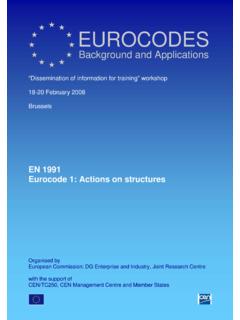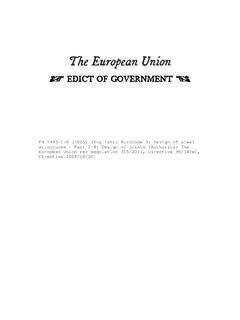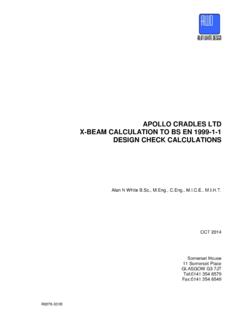Transcription of How to Design Concrete Structures using Eurocode 2
1 A J Bond MA MSc DIC PhD MICE CEngO Brooker BEng CEng MICE MIStructEA J Harris BSc MSc DIC MICE CEng FGST Harrison BSc PhD CEng MICE FICTR M Moss BSc PhD DIC CEng MICE MIStructER S Narayanan FREngR Webster CEng FIStructEHow to Design Concrete Structures using Eurocode 2A cement and Concrete industry publicationForewordThe introduction of European standards to UK construction is a signifi cant event. The ten Design standards, known as the Eurocodes, will affect all Design and construction activities as current British Standards for Design are due to be withdrawn in 2010 at the latest. BS 8110, however, has an earlier withdrawal date of March 2008. The aim of this publication is to make the transition to Eurocode 2: Design of Concrete Structures as easy as possible by drawing together in one place key information and commentary required for the Design and detailing of typical Concrete elements.
2 The cement and Concrete industry recognised that a substantial effort was required to ensure that the UK Design profession would be able to use Eurocode 2 quickly, effectively, effi ciently and with confi dence. With support from government, consultants and relevant industry bodies, the Concrete Industry Eurocode 2 Group (CIEG) was formed in 1999 and this Group has provided the guidance for a co-ordinated and collaborative approach to the introduction of Eurocode 2. Part of the output of the CIEG project was the technical content for 7 of the 11 chapters in this publication. The remaining chapters have been developed by The Concrete content of Chapters 1 and 3 to 8 were produced as part of the project Eurocode 2: transition from UK to European Concrete Design standards.
3 This project was part funded by the DTI under the Partners in Innovation scheme. The lead partner was British Cement Association. The work was carried out under the guidance of the Concrete Industry Eurocode 2 Group and overseen by a Steering Group of the CIEG (members are listed on inside back cover).Particular thanks are due to Robin Whittle, technical editor to the CEN/TC 250/SC2 committee (the committee responsible for structural Eurocodes), who has reviewed and commented on the contents. Thanks are also due to John Kelly and Chris Clear who have contributed to individual Bond, Issy Harvey, Kevin Smith and the designers at Media and Design Associates and Michael Burbridge Ltd have also made essential contributions to the production of this by The Concrete CentreRiverside House, 4 Meadows Business Park, Station Approach, Blackwater, Camberley, Surrey GU17 9 ABTel: +44 (0)1276 606800 Fax: +44 (0)1276 606801 006 Published December 2006 ISBN 1-904818-4-1 Price Group P The Concrete Centre.
4 Joint copyright with British Cement Association for Chapters 1 and 3 to to reproduce extracts from British Standards is granted by British Standards Standards can be obtained from BSI Customer Services, 389 Chiswick High Road, London W4 : +44 (0)20 8996 9001 email: publications are produced on behalf of the Cement and Concrete Industry Publications Forum an industry initiative to publish technical guidance in support of Concrete Design and construction. CCIP publications are available from the Concrete Bookshop at : +44(0)7004-607777 All advice or information from The Concrete Centre (TCC), British Cement Association (BCA) and Quarry Products Association (QPA) is intended for those who will evaluate the signifi cance and limitations of its contents and take responsibility for its use and application.
5 No liability (including that for negligence) for any loss resulting from such advice or information is accepted by TCC, BCA and OPA or their subcontractors, suppliers or advisors. Readers should note that publications from TCC, BCA and OPA are subject to revision from time to time and should therefore ensure that they are in possession of the latest version. Part of this publication has been produced following a contract placed by the Department for Trade and Industry (DTI); the views expressed are not necessarily those of the by Michael Burbridge Ltd, introduction to Eurocodes 12. Getting started 93. Slabs 174. Beams 255. Columns 336. Foundations 437. Flat slabs 518. Defl ection calculations 599. Retaining walls 6710. Detailing 7911.
6 BS 8500 for building Structures 91 How to Design Concrete Structures using Eurocode 2 The Eurocode familyThis chapter shows how to use Eurocode 21with the other Eurocodes. Inparticular it introduces Eurocode :Basis of structural design2and Eurocode 1:Actions on structures3and guides the designer through the process ofdetermining the Design values for actions on a structure . It also gives a briefoverview of the significant differences between the Eurocodes and BS 81104,(which will be superseded) and includes a glossary of Eurocode development of the Eurocodes started in 1975; since then they haveevolved significantly and are now claimed to be the most technicallyadvanced structural codes in the world. The many benefits of using Eurocode 2are summarised below. There are ten Eurocodes covering all the main structuralmaterials (see Figure 1).
7 They are produced by the European Committee forStandardization (CEN), and will replace existing national standards in country is required to publish a Eurocode with a national title page andforward but the original text of the Eurocode must appear as produced byCEN as the main body of the document. A National Annex (NA) can beincluded at the back of the document (see Figure 2). Throughout thispublication it is assumed that the UK National Annexes will be 1 details which existing standards relating to Concrete Design will bereplaced by the new Eurocodes. During the implementation period it isrecommended that existing standards are considered for use where theEuropean standards have not yet been to Design Concrete Structures using Eurocode 21. introduction to EurocodesR S NarayananFREngO BrookerBEng, CEng, MICE, MIStructEBenefits of using Eurocode 2 Learning to use the new Eurocodes will require time and effort onbehalf of the designer, so what benefits will there be?
8 New Eurocodes are claimed to be the most technicallyadvanced codes in the 2 should result in more economic Structures than BS Eurocodes are logical and organised to avoid 2 is less restrictive than existing 2 is more extensive than existing of the Eurocodes will provide more opportunity for designersto work throughout Europe all public works must allow the Eurocodes to be 2 Typical Eurocode layoutTable 1 Concrete related Eurocodes and their equivalent current standardsFigure 1 The EurocodesEurocodeTitleSuperseded standards BS EN 1990 Basis of structural designBS 8110: Part 1 section 2BS EN 1991 1 1 Densities, self-weight and BS 6399: Part 1 and BS 648imposed loadsBS EN 1991 1 2 Actions on Structures exposed to fireBS EN 1991 1 3 Snow loadsBS 6399: Part 2BS EN 1991 1 4 Wind actionsBS 6399: Part 3BS EN 1991 1 5 Thermal actions BS EN 1991 1 6 Actions during execution BS EN 1991 1 7 Accidental actions BS EN 1991 2 Traffic loads on bridgesBD 37/88BS EN 1991 3 Actions induced by cranes and machineryBS EN 1991 4 Silos and tanks BS EN 1992 1 1 General rules for buildingsBS 8110: Parts 1, 2 and 3BS EN 1992 1 2 Fire resistance of Concrete BS 8110: Part 1, Table andstructuresBS 8110: Part 2, section 4BS EN 1992 2 BridgesBS 5400.
9 Part 4BS EN 1992 3 Liquid-retaining and BS 8007containment structuresBS EN 1997 1 Geotechnical Design BS 6031, BS 8002, BS 8004,General rulesBS 8006, BS 8008 & BS 8081BS EN 1997 2 Geotechnical Design Ground BS 5930investigation and testingBS EN 1998 Design of Structures for earthquake resistance (6 parts)Structural safety,serviceability and durabilityActions on structuresDesign and detailingGeotechnicaland seismicdesignA:National title pageB:National ForewordC:CEN title pageD:Main textE:Main Annex(es)F:National AnnexBS EN 1990, Eurocode :Basis of structural designBS EN 1991, Eurocode 1:Actions on structuresBS EN 1992, Eurocode 2:ConcreteBS EN 1993, Eurocode 3:SteelBS EN 1994, Eurocode 4:CompositeBS EN 1995, Eurocode 5:TimberBS EN 1996, Eurocode 6:MasonryBS EN 1999, Eurocode 9:AluminiumBS EN 1997, Eurocode 7:Geotechnical designBS EN 1998, Eurocode 8:Seismic designDDDDCBAE urocode: Basis ofstructural designThis Eurocode underpins all structural Design irrespective of thematerial of construction.
10 It establishes principles and requirements forsafety, serviceability and durability of Structures . (Note, the correct titleis Eurocode not Eurocode 0.) The Eurocode uses a statistical approachto determine realistic values for actions that occur in combination witheach is no equivalent British Standard for Eurocode :Basis of structuraldesignand the corresponding information has traditionally beenreplicated in each of the material Eurocodes. It also introduces newdefinitions (see Glossary) and symbols (see Tables 2a and 2b), whichwill be used throughout this publication to assist familiarity. Partialfactors for actions are given in this Eurocode , whilst partial factors formaterials are prescribed in their relevant valuesFor each variable action there are four representative values.







